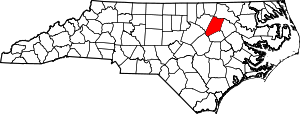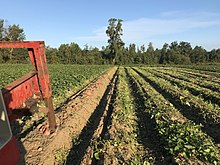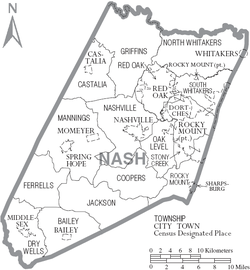Nash County, North Carolina
Nash County | |
|---|---|
 Nash County Courthouse in Nashville | |
| Motto: "Where Business meets Opportunity" | |
 Location within the U.S. state of North Carolina | |
 North Carolina's location within the U.S. | |
| Coordinates: 35°58′N 77°59′W / 35.97°N 77.99°W | |
| Country | |
| State | |
| Founded | 1777 |
| Named for | Francis Nash |
| Seat | Nashville |
| Largest community | Rocky Mount |
| Area | |
• Total | 542.82 sq mi (1,405.9 km2) |
| • Land | 540.44 sq mi (1,399.7 km2) |
| • Water | 2.38 sq mi (6.2 km2) 0.44% |
| Population (2020) | |
• Total | 94,970 |
• Estimate (2023) | 96,551 |
| • Density | 175.73/sq mi (67.85/km2) |
| Time zone | UTC−5 (Eastern) |
| • Summer (DST) | UTC−4 (EDT) |
| Congressional district | 1st |
| Website | nashcountync |
Nash County is a county located in the U.S. state of North Carolina. As of the 2020 census, the population was 94,970.[1] Its county seat is Nashville.[2]
Nash County is part of the Rocky Mount, NC Metropolitan Statistical Area.
History
[edit]The area eventually comprising Nash County was originally organized as a part of Edgecombe County. Settlement first occurred in the 1740s;[3] the earliest land grants date to 1743.[4] As the population of Edgecombe increased, citizens in the western portion of the county found it difficult to travel to the county seat of Tarboro to conduct official business. Legislator Nathan Boddie proposed to the North Carolina Provincial Congress that the county be divided.[3] As a result, Nash was formed from all parts of Edgecombe west of the Falls of the Tar River in 1777.[5][6] It was named for American Revolutionary War Brigadier General Francis Nash, who was mortally wounded at the Battle of Germantown.[5] The first U.S. Census in 1790 recorded a population of over 7,300.[3] In 1815 the county seat was designated as Nashville.[7] The town was incorporated in 1823.[8] In 1833 the county's first courthouse burned down and was replaced by a brick building.[8]
Several early communities in Nash County developed as stops along stagecoach routes, including Dortches, Red Oak, Stanhope, Hilliardston, and Castalia.[9] Settlement also occurred along rivers and creeks, accompanied by the construction of gristmills.[10] In the 1830s the Wilmington and Weldon Railroad was laid, leading to further settlement. The building of a spur line in 1840 led to the eventual creation of the community of Whitakers.[11] By the 1860s, Nash County had a population over 11,600 and an economy centered on agriculture.[10] In 1855, parts of Nash, Edgecombe, Johnston, and Wayne counties were combined to form Wilson County.[12] Over 1,000 men from the county fought in the American Civil War.[10]
In 1871, after significant political controversy, all parts of Edgecombe County west of the Wilmington and Weldon Railroad were annexed to Nash[13][6] leading to the bifurcation of the Edgecombe communities of Battleboro and Sharpsburg between the two counties. As a result of the boundary shift, a greater portion of the town of Rocky Mount also lay within Nash County's border, including Rocky Mount Mills, the second textile mill to exist within in the state.[6] In 1899, the Atlantic Coast Line Railroad established repair shops in Rocky Mount, precipitating the city's rapid growth.[10] In 1921 the county's third courthouse was built.[8]
Geography
[edit]Nash County rests in the northeastern part of North Carolina[4] along the dividing line between the Peidmont and Coastal Plain regions.[3] According to the U.S. Census Bureau, the county has a total area of 542.82 square miles (1,405.9 km2), of which 540.44 square miles (1,399.7 km2) is land and 2.38 square miles (6.2 km2) (0.44%) is covered by water.[14] Elevation in the county gradually rises from the east to the west.[15]
State and local protected areas
[edit]- Flower Hill Nature Preserve (part)
- Sandy Creek Game Land (part)[16]
- Shocco Creek Game Land (part)[16]
Major water bodies
[edit]- Fishing Creek[3]
- Moccasin Creek[3]
- Pig Basket Creek
- Sapony Creek[3]
- Stoney Creek[3]
- Swift Creek[3]
- Tar River[3]
- Tar River Reservoir
- Toisnot Swamp
- Turkey Creek
Adjacent counties
[edit]- Franklin County – west
- Johnston County – southwest
- Wake County – southwest
- Wilson County – south
- Edgecombe County – east
- Halifax County – northeast
- Warren County – north
Major highways
[edit]
 Future I-87
Future I-87 I-95[17]
I-95[17]
 Future I-587
Future I-587 US 64[17]
US 64[17]
 US 64 Alt.
US 64 Alt.
 US 64 Bus. (Nashville)
US 64 Bus. (Nashville)
 US 64 Bus. (Rocky Mount)
US 64 Bus. (Rocky Mount) US 264[17]
US 264[17]
 US 264 Alt.
US 264 Alt. US 301
US 301
 US 301 Bus.
US 301 Bus. NC 4
NC 4 NC 33
NC 33 NC 43
NC 43
 NC 43 Bus.
NC 43 Bus. NC 48
NC 48 NC 56
NC 56 NC 58
NC 58 NC 97
NC 97 NC 98
NC 98 NC 231
NC 231 NC 561
NC 561 NC 581
NC 581
Major infrastructure
[edit]Demographics
[edit]2020 census
[edit]| Race | Number | Percentage |
|---|---|---|
| White (non-Hispanic) | 46,317 | 48.77% |
| Black or African American (non-Hispanic) | 36,679 | 38.62% |
| Native American | 615 | 0.65% |
| Asian | 904 | 0.95% |
| Pacific Islander | 28 | 0.03% |
| Other/Mixed | 3,105 | 3.27% |
| Hispanic or Latino | 7,322 | 7.71% |
As of the 2020 census, there were 94,970 people, 37,574 households, and 27,002 families residing in the county.
Demographic change
[edit]| Historical population | ||||||||||||||||||||||||||||||||||||||||||||||||||||||||||||||||||||||||||||||||||||||||||||||||||||||||||||
| ||||||||||||||||||||||||||||||||||||||||||||||||||||||||||||||||||||||||||||||||||||||||||||||||||||||||||||
After decades of growth, between 2010 and 2020, Nash County recorded an almost one percent population loss.[17]
Government and politics
[edit]Government
[edit]Nash County is run by a commission–manager government. Legislative and policy-making power is vested in a seven-member board of commissioners, with the commissioners elected in districts to serve four-year staggered terms. The board passes ordinances, adopts the county budget, and appoints the county manager. The manager wields executive authority over county administration, appoints directors of county government departments, and implement the commission's decisions. County government provides various services, including public safety, social services, cultural activities, and the provision of utilities.[24]
Nash County is represented in the General Assembly by the Senate's 11th district and the House of Representatives' 24th and 25th districts.[25] It lies within the bounds of North Carolina's 8th Prosecutorial District, the 8A Superior Court District, and the 8th District Court District.[26]
Nash County is a member of the regional Upper Coastal Plain Council of Governments.
Politics
[edit]From the turn of the 20th century North Carolina established barriers that effectively disfranchised the large black population, which had been supporting Republican candidates. Conservative whites voted overwhelmingly Democratic and the county and state were part of the resulting political "Solid South" county. Although it gave a plurality to Populist candidate James B. Weaver in 1892, unlike Sampson County or Alabama's Chilton County, it did not subsequently turn to the Republican Party.
Nash County would vote Democratic in every election from 1896 to 1964 – in Franklin D. Roosevelt and Harry S. Truman's five elections, the Republicans never received eleven percent of the county's limited electorate's ballots. Many whites supported George Wallace's American Independent candidacy in 1968, after passage of the Voting Rights Act. More voted Republican for the first time in 1972.
While Nash voters supported favorite son and Southern Democrat Jimmy Carter in 1976, the county's majority white voters shifted to Republican candidates from 1980 to 2004. But the last four elections have been closely contested. The margin of victory has been less than 1,000 votes in every election since.[27][28] Nash County has emerged in recent years as a swing county and a bellwether county. As of 2024, it is the only North Carolina county to support the winning U.S. presidential election four times in a row, supporting Barack Obama in 2012, Donald Trump in 2016, Joe Biden in 2020, and Trump in 2024. In 2024, it also split its majority vote between Republican and Democratic statewide candidates.[29]
| Year | Republican | Democratic | Third party(ies) | |||
|---|---|---|---|---|---|---|
| No. | % | No. | % | No. | % | |
| 2024 | 26,431 | 50.37% | 25,508 | 48.61% | 532 | 1.01% |
| 2020 | 25,827 | 49.41% | 25,947 | 49.64% | 497 | 0.95% |
| 2016 | 23,319 | 48.92% | 23,235 | 48.75% | 1,111 | 2.33% |
| 2012 | 23,842 | 49.17% | 24,313 | 50.14% | 337 | 0.69% |
| 2008 | 23,728 | 50.36% | 23,099 | 49.02% | 291 | 0.62% |
| 2004 | 21,902 | 58.14% | 15,693 | 41.66% | 78 | 0.21% |
| 2000 | 17,995 | 58.97% | 12,376 | 40.56% | 142 | 0.47% |
| 1996 | 15,309 | 54.17% | 11,142 | 39.42% | 1,811 | 6.41% |
| 1992 | 14,446 | 48.34% | 10,809 | 36.17% | 4,631 | 15.50% |
| 1988 | 15,906 | 64.34% | 8,740 | 35.35% | 76 | 0.31% |
| 1984 | 17,295 | 66.73% | 8,588 | 33.14% | 34 | 0.13% |
| 1980 | 11,043 | 56.34% | 8,184 | 41.75% | 374 | 1.91% |
| 1976 | 8,477 | 48.12% | 8,937 | 50.73% | 202 | 1.15% |
| 1972 | 12,679 | 71.39% | 4,503 | 25.35% | 579 | 3.26% |
| 1968 | 4,602 | 24.08% | 5,283 | 27.64% | 9,230 | 48.29% |
| 1964 | 6,396 | 41.11% | 9,163 | 58.89% | 0 | 0.00% |
| 1960 | 3,896 | 27.86% | 10,086 | 72.14% | 0 | 0.00% |
| 1956 | 2,665 | 21.09% | 9,969 | 78.91% | 0 | 0.00% |
| 1952 | 2,636 | 20.18% | 10,424 | 79.82% | 0 | 0.00% |
| 1948 | 684 | 7.98% | 7,590 | 88.50% | 302 | 3.52% |
| 1944 | 876 | 10.36% | 7,577 | 89.64% | 0 | 0.00% |
| 1940 | 613 | 6.76% | 8,456 | 93.24% | 0 | 0.00% |
| 1936 | 517 | 5.62% | 8,682 | 94.38% | 0 | 0.00% |
| 1932 | 532 | 6.61% | 7,472 | 92.79% | 49 | 0.61% |
| 1928 | 2,066 | 32.72% | 4,249 | 67.28% | 0 | 0.00% |
| 1924 | 823 | 20.16% | 3,129 | 76.63% | 131 | 3.21% |
| 1920 | 1,556 | 27.85% | 4,031 | 72.15% | 0 | 0.00% |
| 1916 | 826 | 27.22% | 2,189 | 72.15% | 19 | 0.63% |
| 1912 | 172 | 6.49% | 1,862 | 70.21% | 618 | 23.30% |
| 1908 | 1,334 | 44.29% | 1,678 | 55.71% | 0 | 0.00% |
| 1904 | 645 | 31.02% | 1,428 | 68.69% | 6 | 0.29% |
| 1900 | 1,337 | 33.96% | 2,600 | 66.04% | 0 | 0.00% |
| 1896 | 1,699 | 36.81% | 2,916 | 63.17% | 1 | 0.02% |
| 1892 | 476 | 16.96% | 997 | 35.53% | 1,333 | 47.51% |
| 1888 | 1,719 | 44.08% | 2,181 | 55.92% | 0 | 0.00% |
| 1884 | 1,556 | 45.75% | 1,845 | 54.25% | 0 | 0.00% |
| 1880 | 1,406 | 46.59% | 1,612 | 53.41% | 0 | 0.00% |
Sheriff
[edit]The Sheriff's Office provides police services for the unincorporated areas of the county.
Economy
[edit]As of 2023, the biggest sectors in Nash County's economy were manufacturing, healthcare and social services, retail, food and accommodation services, and education.[31]

As of 2023, over 40 percent of the county's area is cultivated farmland. Its top agricultural products are poultry, eggs, tobacco, and sweetpotatoes.[32] Nash is one of the top sweetpotato-producing counties in the state.[32][33]
Communities
[edit]
Cities
[edit]- Rocky Mount (largest community; parts located in Edgecombe County)
Towns
[edit]- Bailey
- Castalia
- Dortches
- Middlesex
- Momeyer
- Nashville (county seat)
- Red Oak
- Spring Hope
- Sharpsburg (part)
- Whitakers (part)
- Zebulon (part)
Townships
[edit]- Bailey
- Battleboro
- Castalia
- Coopers
- Dry Wells
- Ferrells
- Griffins
- Jackson
- Mannings
- Nashville
- North Whitakers
- Oak Level
- Red Oak
- Rocky Mount
- Spring Hope
- South Whitakers
- Stony Creek
Unincorporated community
[edit]See also
[edit]- List of counties in North Carolina
- National Register of Historic Places listings in Nash County, North Carolina
- Haliwa-Saponi, state-recognized tribe that resides in the county
- Nash Community College, located near Nashville
References
[edit]- ^ a b c "QuickFacts: Nash County, North Carolina". United States Census Bureau. Retrieved March 21, 2024.
- ^ "Find a County". National Association of Counties. Retrieved June 7, 2011.
- ^ a b c d e f g h i j Fleming 1998, p. 7.
- ^ a b "History of Nash County". Nash County, North Carolina. Retrieved November 17, 2024.
- ^ a b Corbitt 2000, p. 157.
- ^ a b c Kelley, Lucas. "The Historical Origins of the 1871 Nash-Edgecombe County Line". Digital Rocky Mount Mills. Community Histories Workshop, University of North Carolina at Chapel Hill. Retrieved November 15, 2024.
- ^ Corbitt 2000, pp. 157–158.
- ^ a b c Fleming 1998, p. 9.
- ^ Fleming 1998, pp. 7–8.
- ^ a b c d Fleming 1998, p. 8.
- ^ Fleming 1998, pp. 8, 21.
- ^ Corbitt 2000, p. 158.
- ^ Corbitt 2000, p. 159.
- ^ "2020 County Gazetteer Files – North Carolina". United States Census Bureau. August 23, 2022. Retrieved September 9, 2023.
- ^ Fleming 1998, p. 5.
- ^ a b "NCWRC Game Lands". www.ncpaws.org. Retrieved March 30, 2023.
- ^ a b c d Barkin, Dan (October 17, 2021). "20 miles from Raleigh, Nash County launches new economic development effort". Business North Carolina. Retrieved November 18, 2024.
- ^ "Explore Census Data". data.census.gov. Retrieved December 24, 2021.
- ^ "U.S. Decennial Census". United States Census Bureau. Retrieved January 18, 2015.
- ^ "Historical Census Browser". University of Virginia Library. Retrieved January 18, 2015.
- ^ Forstall, Richard L., ed. (March 27, 1995). "Population of Counties by Decennial Census: 1900 to 1990". United States Census Bureau. Retrieved January 18, 2015.
- ^ "Census 2000 PHC-T-4. Ranking Tables for Counties: 1990 and 2000" (PDF). United States Census Bureau. April 2, 2001. Archived (PDF) from the original on March 27, 2010. Retrieved January 18, 2015.
- ^ "State & County QuickFacts". United States Census Bureau. Retrieved October 27, 2013.[permanent dead link]
- ^ Wood 2023, p. iii.
- ^ "Nash County Representation : 2023-2024 Session". North Carolina General Assembly. Retrieved November 20, 2024.
- ^ "Nash County". North Carolina Judicial Branch. Retrieved November 15, 2024.
- ^ "Dave Leip's Atlas of U.S. Presidential Elections". uselectionatlas.org. Retrieved December 22, 2022.
- ^ "Anatomy of a swing state: What these 6 counties tell us about the upcoming NC election". The Charlotte Observer. November 4, 2022. Retrieved November 4, 2022.
- ^ "NC county gets presidential prediction right yet again by backing Trump in 2024". The Charlotte Observer. November 7, 2024. Retrieved November 10, 2024.
- ^ Leip, David. "Dave Leip's Atlas of U.S. Presidential Elections". uselectionatlas.org. Retrieved March 16, 2018.
- ^ Wood 2023, p. v.
- ^ a b Wood 2023, p. vi.
- ^ Ellis, Kevin (February 23, 2024). "Sweetpotato or sweet potato? Here's why N.C. group says one word is right". Business North Carolina. Retrieved November 19, 2024.
Works cited
[edit]- Corbitt, David Leroy (2000). The formation of the North Carolina counties, 1663-1943 (reprint ed.). Raleigh: North Carolina Division of Archives and History. OCLC 46398241.
- Fleming, Monika S. (1998). Rocky Mount and Nash County. Charleston: Arcadia Publishing. ISBN 9781439635407.
- Wood, Donna (2023), Annual Comprehensive Financial Report Fiscal Year Ended June 30, 2023, Nash County, North Carolina
External links
[edit] Geographic data related to Nash County, North Carolina at OpenStreetMap
Geographic data related to Nash County, North Carolina at OpenStreetMap- NCGenWeb Nash County, genealogy resources for the county




